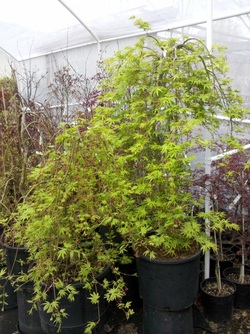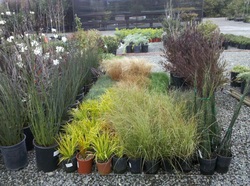Below please find our plant list for the garden, also viewable on the Garden Design page!
Trees and Bamboo
Acer palmatum 'Ryusen' / Japanese Maple (world's rarest cultivar)
Acer palmatum 'Tobiosho' / Japanese Maple
Acer palmatum dissectum 'Ever Red' / Laceleaf Japanese Maple
Magnolia stellata 'Royal Star' / Star Magnolia
Phyllostachys aureosulcata 'Spectabilis' / Yellow Crook Stem Bamboo
Phyllostachis nigra / Black Bamboo
Podocarpus elongatus 'Icee Blue' / Yellowwood
Shrubs & Grasses
Acorus gramineus 'Ogon' / Golden Sweet Flag
Carex elegantissima / Golden-edged Sedge
Carex flagellifera / Weeping Brown Sedge
Carex testacea / New Zealand Orange Sedge
Cordyline 'Festival Grass' / Red Fountain Cordyline
Festuca glauca 'Elijah Blue' / Blue Fescue
Helichrysum petiolare / Licorice plant
Helictotrichon sempervirens / Blue Oat Grass
Heuchera 'Regina' / Coral Bells
Heuchera 'Hercules' / Coral Bells
Libertia peregrinans / Orange Libertia
Phormium 'Maori Maiden' / New Zealand Flax
Phormium 'Platt's Black' / New Zealand Flax
Phormium 'Dark Delight' / New Zealand Flax
Phormium 'Yellow Wave' / New Zealand Flax
Stipa tenuissima (aka Nasella tenuissima) / Mexican Feather Grass
Graywater Stream Planting
Acorus gramineus 'Ogon' / Golden Sweet Flag
Equisetum hyemale / Horsetail
Chondropetalum elephantinum / Large Cape Rush
Chondropetalum tectorum / Cape Rush
Juncus patens 'Elk Blue' / California Gray Rush
Trees and Bamboo
Acer palmatum 'Ryusen' / Japanese Maple (world's rarest cultivar)
Acer palmatum 'Tobiosho' / Japanese Maple
Acer palmatum dissectum 'Ever Red' / Laceleaf Japanese Maple
Magnolia stellata 'Royal Star' / Star Magnolia
Phyllostachys aureosulcata 'Spectabilis' / Yellow Crook Stem Bamboo
Phyllostachis nigra / Black Bamboo
Podocarpus elongatus 'Icee Blue' / Yellowwood
Shrubs & Grasses
Acorus gramineus 'Ogon' / Golden Sweet Flag
Carex elegantissima / Golden-edged Sedge
Carex flagellifera / Weeping Brown Sedge
Carex testacea / New Zealand Orange Sedge
Cordyline 'Festival Grass' / Red Fountain Cordyline
Festuca glauca 'Elijah Blue' / Blue Fescue
Helichrysum petiolare / Licorice plant
Helictotrichon sempervirens / Blue Oat Grass
Heuchera 'Regina' / Coral Bells
Heuchera 'Hercules' / Coral Bells
Libertia peregrinans / Orange Libertia
Phormium 'Maori Maiden' / New Zealand Flax
Phormium 'Platt's Black' / New Zealand Flax
Phormium 'Dark Delight' / New Zealand Flax
Phormium 'Yellow Wave' / New Zealand Flax
Stipa tenuissima (aka Nasella tenuissima) / Mexican Feather Grass
Graywater Stream Planting
Acorus gramineus 'Ogon' / Golden Sweet Flag
Equisetum hyemale / Horsetail
Chondropetalum elephantinum / Large Cape Rush
Chondropetalum tectorum / Cape Rush
Juncus patens 'Elk Blue' / California Gray Rush


 RSS Feed
RSS Feed